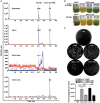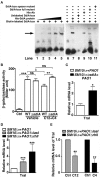Quorum Sensing N-acyl Homoserine Lactones-SdiA Suppresses Escherichia coli- Pseudomonas aeruginosa Conjugation through Inhibiting traI Expression
- PMID: 28164039
- PMCID: PMC5247672
- DOI: 10.3389/fcimb.2017.00007
Quorum Sensing N-acyl Homoserine Lactones-SdiA Suppresses Escherichia coli- Pseudomonas aeruginosa Conjugation through Inhibiting traI Expression
Abstract
Conjugation is a key mechanism for horizontal gene transfer and plays an important role in bacterial evolution, especially with respect to antibiotic resistance. However, little is known about the role of donor and recipient cells in regulation of conjugation. Here, using an Escherichia coli (SM10λπ)-Pseudomonas aeruginosa (PAO1) conjugation model, we demonstrated that deficiency of lasI/rhlI, genes associated with generation of the quorum sensing signals N-acyl homoserine lactones (AHLs) in PAO1, or deletion of the AHLs receptor SdiA in the donor SM10λπ both facilitated conjugation. When using another AHLs-non-producing E. coli strain EC600 as recipient cells, deficiency of sdiA in donor SM10λπ hardly affect the conjugation. More importantly, in the presence of exogenous AHLs, the conjugation efficiency between SM10λπ and EC600 was dramatically decreased, while deficiency of sdiA in SM10λπ attenuated AHLs-inhibited conjugation. These data suggest the conjugation suppression function of AHLs-SdiA chemical signaling. Further bioinformatics analysis, β-galactosidase reporter system and electrophoretic mobility shift assays characterized the binding site of SdiA on the promoter region of traI gene. Furthermore, deletion of lasI/rhlI or sdiA promoted traI mRNA expression in SM10λπ and PAO1 co-culture system, which was abrogated by AHLs. Collectively, our results provide new insight into an important contribution of quorum sensing system AHLs-SdiA to the networks that regulate conjugation.
Keywords: N-acyl homoserine lactones; P. aeruginosa; SdiA; antibiotic resistance; conjugation.
Figures



Similar articles
-
Antibiotics Promote Escherichia coli-Pseudomonas aeruginosa Conjugation through Inhibiting Quorum Sensing.Antimicrob Agents Chemother. 2017 Nov 22;61(12):e01284-17. doi: 10.1128/AAC.01284-17. Print 2017 Dec. Antimicrob Agents Chemother. 2017. PMID: 28993333 Free PMC article.
-
Small RNA GadY in Escherichia coli enhances conjugation system of IncP-1 by targeting SdiA.Front Cell Infect Microbiol. 2024 Jul 23;14:1445850. doi: 10.3389/fcimb.2024.1445850. eCollection 2024. Front Cell Infect Microbiol. 2024. PMID: 39108982 Free PMC article.
-
Structural and mechanistic roles of novel chemical ligands on the SdiA quorum-sensing transcription regulator.mBio. 2015 Mar 31;6(2):e02429-14. doi: 10.1128/mBio.02429-14. mBio. 2015. PMID: 25827420 Free PMC article.
-
SdiA sensing of acyl-homoserine lactones by enterohemorrhagic E. coli (EHEC) serotype O157:H7 in the bovine rumen.Gut Microbes. 2010 Nov-Dec;1(6):432-5. doi: 10.4161/gmic.1.6.14177. Gut Microbes. 2010. PMID: 21468228 Free PMC article. Review.
-
Eavesdropping by bacteria: the role of SdiA in Escherichia coli and Salmonella enterica serovar Typhimurium quorum sensing.Foodborne Pathog Dis. 2011 Feb;8(2):169-78. doi: 10.1089/fpd.2010.0651. Epub 2010 Oct 30. Foodborne Pathog Dis. 2011. PMID: 21034261 Review.
Cited by
-
Bacterial Concentrations and Water Turbulence Influence the Importance of Conjugation Versus Phage-Mediated Antibiotic Resistance Gene Transfer in Suspended Growth Systems.ACS Environ Au. 2021 Nov 30;2(2):156-165. doi: 10.1021/acsenvironau.1c00027. eCollection 2022 Mar 16. ACS Environ Au. 2021. PMID: 37101581 Free PMC article.
-
Synergistic Inhibitory Effect of Polymyxin B in Combination with Ceftazidime against Robust Biofilm Formed by Acinetobacter baumannii with Genetic Deficiency in AbaI/AbaR Quorum Sensing.Microbiol Spectr. 2022 Feb 23;10(1):e0176821. doi: 10.1128/spectrum.01768-21. Epub 2022 Feb 23. Microbiol Spectr. 2022. PMID: 35196792 Free PMC article.
-
Antibiotics Promote Escherichia coli-Pseudomonas aeruginosa Conjugation through Inhibiting Quorum Sensing.Antimicrob Agents Chemother. 2017 Nov 22;61(12):e01284-17. doi: 10.1128/AAC.01284-17. Print 2017 Dec. Antimicrob Agents Chemother. 2017. PMID: 28993333 Free PMC article.
-
Small RNA GadY in Escherichia coli enhances conjugation system of IncP-1 by targeting SdiA.Front Cell Infect Microbiol. 2024 Jul 23;14:1445850. doi: 10.3389/fcimb.2024.1445850. eCollection 2024. Front Cell Infect Microbiol. 2024. PMID: 39108982 Free PMC article.
-
Soil Component: A Potential Factor Affecting the Occurrence and Spread of Antibiotic Resistance Genes.Antibiotics (Basel). 2023 Feb 4;12(2):333. doi: 10.3390/antibiotics12020333. Antibiotics (Basel). 2023. PMID: 36830244 Free PMC article. Review.
References
MeSH terms
Substances
LinkOut - more resources
Full Text Sources
Other Literature Sources

